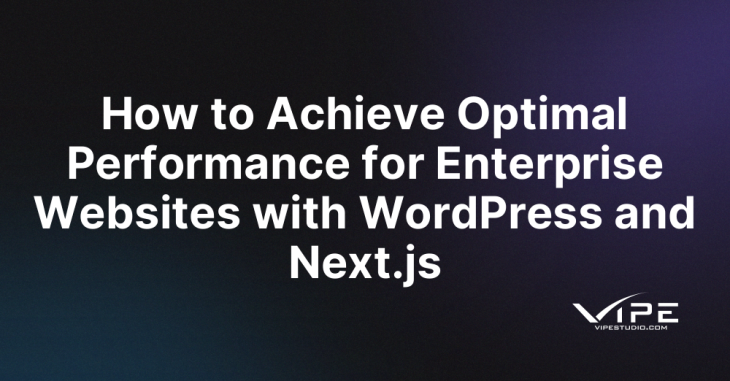How to Achieve Optimal Performance for Enterprise Websites with WordPress and Next.js

READING TIME: MIN
As businesses scale and expand their online presence, website performance becomes a key priority. For enterprise-level websites, where traffic, content volume, and user experience are paramount, a high-performing site is essential. One of the best ways to optimize performance for these large-scale websites is by integrating WordPress with Next.js. In this article, we will explore how this powerful combination can help businesses build fast, reliable, and user-friendly websites that cater to the needs of both users and search engines.
The Importance of Website Performance for Enterprises
Website performance is no longer just a “nice-to-have” feature; it’s a critical component that directly impacts user experience, SEO rankings, and conversion rates. Slow-loading websites lead to higher bounce rates, lower engagement, and missed opportunities for businesses. For enterprises, this means a loss in potential revenue, reputation, and customer trust. A performant website can be the difference between a lead converting into a sale and a visitor abandoning the site. That’s where the combination of WordPress and Next.js comes in—offering robust solutions to address these challenges.
What Makes WordPress and Next.js a Powerful Duo?
WordPress is widely recognized for its flexibility and ease of use as a content management system. On the other hand, Next.js is a React-based framework designed for high-performance web development. Together, these two technologies provide the perfect foundation for building modern, dynamic websites with optimal performance. Here’s why the combination works so well:

- Server-Side Rendering (SSR) and Static Site Generation (SSG): Next.js offers built-in support for SSR and SSG, allowing for faster content delivery and better SEO performance. By pre-rendering pages on the server or at build time, websites can load instantly, even with large amounts of content.
- Decoupled Architecture: By using WordPress as a headless CMS and Next.js as the front-end framework, the website’s front-end and back-end are decoupled. This decoupling allows for greater flexibility in design and functionality, making it easier to build custom user interfaces without limitations.
- Improved User Experience: Next.js ensures smooth, fast navigation with features like automatic code splitting and lazy loading. This reduces the initial load time of the site and ensures that users have a seamless browsing experience, especially on mobile devices.
How Next.js Enhances WordPress’s Content Management Capabilities
WordPress is renowned for its user-friendly CMS, making it easy for non-technical users to manage and publish content. However, WordPress’s traditional front-end rendering can sometimes slow down websites, especially for larger enterprises. This is where Next.js comes in, providing a modern front-end that optimizes content delivery while maintaining WordPress’s intuitive content management features. Here’s how Next.js enhances WordPress:
- Fast Content Delivery: With Next.js, pages are pre-rendered on the server, allowing content to be delivered quickly to users. This ensures that WordPress’s CMS is used effectively for content creation and management, without compromising performance.
- SEO Advantages: Next.js automatically handles SEO optimizations, such as server-side rendering, meta tags, and structured data, ensuring that your WordPress site performs well in search engine rankings.
- Enhanced Customization: With Next.js, developers have full control over the website’s front-end design and functionality. This means that businesses can create unique and customized user interfaces while still using WordPress for content management.
Best Practices for Optimizing Performance with WordPress and Next.js
To achieve optimal performance for enterprise websites, businesses should follow best practices when integrating WordPress with Next.js. Here are some key steps to ensure your website performs at its best:
- Use Static Site Generation (SSG) Where Possible: Next.js’s static site generation feature is perfect for delivering content that doesn’t change often. By pre-generating HTML pages at build time, websites can serve content instantly without relying on server-side rendering for every request, resulting in faster load times.
- Leverage Incremental Static Regeneration (ISR): For sites with frequently updated content, Next.js’s Incremental Static Regeneration allows you to update static pages without rebuilding the entire site. This means that new or updated content can be served to users in near real-time without sacrificing performance.
- Optimize API Calls: The integration between WordPress and Next.js relies on APIs to fetch content. To improve performance, ensure that the API calls are efficient, only fetching the necessary data and minimizing unnecessary requests.
- Implement Caching and Content Delivery Networks (CDNs): Caching is crucial for reducing server load and improving website performance. By using a CDN to deliver static content globally, users can access the website faster, regardless of their location.
Scaling Your Enterprise Website with WordPress and Next.js
As enterprises grow, so do their website needs. Websites must be able to handle increased traffic, manage more content, and deliver fast, seamless user experiences across different devices. Next.js’s architecture is built to scale, making it an ideal solution for enterprises that need to expand their online presence while maintaining optimal performance.

When combined with WordPress, Next.js allows enterprises to scale both the back-end (content management) and the front-end (user experience) seamlessly. The decoupled architecture ensures that businesses can update the front-end without disrupting the back-end CMS, allowing for continuous growth without compromising the user experience.
Conclusion: Why WordPress and Next.js Are the Future of Enterprise Websites
WordPress and Next.js offer a powerful combination for enterprise websites, providing businesses with the performance, scalability, and flexibility they need to stay competitive in today’s fast-paced digital world. By integrating these two technologies, enterprises can build high-performance websites that deliver fast load times, improved SEO, and an exceptional user experience. As more businesses adopt this approach, WordPress and Next.js will undoubtedly shape the future of web development for enterprises.
If you’re ready to take your enterprise website to the next level with Next.js and WordPress, contact Vipe Studio for expert guidance and development.


